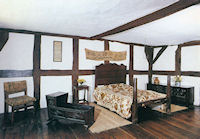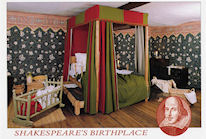

Figure 63: The birth room at Shakespeare's birthplace in the 1980s © Heritage House Group
Figure 64: The birth room at Shakespeare's birthplace in the 2000s © Jigsaw Design and Publishing Ltd and The Shakespeare Birthplace Trust
The changes to historic houses discussed through the case studies presented in this article have impacts on the structure of the buildings, on the ways in which people move through them, and on how people understand them. The reconstruction and interpretation of historic houses is an essential part of the connection between the place in the past and the present: 'The link between archaeology/artefact and public becomes "interpretation" of archaeology/artefact/history' (Shanks and Tilley 1987, 91).
It would be impossible to reconstruct the experiences of visitors at different times since the 1870s, as such experiences are individual and personal, and transient and intangible. However, an understanding of the ways in which interpretation in historic houses has changed can shed light on the opportunities presented to visitors to gain an experience of the place and its history.
People visit historic houses for a range of different reasons. The experience, understanding and knowledge they take away from the place will vary from person to person.
Visitors to cultural heritage locations have multiple goals. Often they want to get information about the objects they see. However, sharing the experience with their companions is often a higher priority than education, particularly for infrequent visitors. Similarly, a 'romantic' experience, one in which the visitor 'gets the sense of the place', is often prioritized more highly than education by both curators and visitors [2]. Therefore, at least three entities demand the visitor's attention at a cultural heritage site: (1) an information source (e.g., a guidebook); (2) their companions; and (3) the location itself (Woodruff et al. 2001, 1).
The motivations behind historic houses being opened to the public has evolved. One key motivation in the Victorian period was the philanthropic desire to educate people in order to encourage moral and social improvement (Ward 1883). Some contemporary debate and descriptions challenge whether everyone should have the right to visit historic houses (Tinniswood 1998), and the visitor in this period may have felt insecure about the very process of visiting historic buildings.
The achievement of preserving historic houses through displaying them to the public and generating income for maintenance was shared across Europe and beyond. Some commentators see the National Trust Country Houses scheme as an unusual example, however, as families were able to stay in their houses even though they were owned and opened to the public by the Trust. 'Britain is unique in enabling country houses to be homes and national monuments simultaneously' (Chamberlain 1979, 886-9). This affects the experience of visitors as interpretation is likely to be more discreet, and commonly takes the form of tours of the building.
The folk life movement and the opening of folk museums, together with the advent of living history, have been seen as among the greatest developments of the 20th century in interpretation of the past (Walsh 1992, 39). The history of ordinary people's lives and vernacular buildings were increasingly valued. However, the attempts of open-air museums to re-enact historic life has been critiqued, 'Colonial Williamsburg may be archaeologically rigorous, but it cannot re-establish the continuity of living history' (Philpott 1996, 223). The experience of visitors is therefore that of a temporary modern replication of a past lifestyle. Even with living history interpretation it may be difficult for visitors to differentiate between the modern and historic meaning instilled in spaces - the differences in the ways in which spaces are used and the activities which take place within them.
As visitor attractions other than historic houses and museums have employed related types of interpretation, the distinctiveness of historical interpretation has altered, and further research is needed on visitor understanding of the historical basis of reconstructions. A discussion of the use of historical motifs at Disneyland describes Main Street, Disneyland as, 'ostensibly grounded in historic reality' (Wallace 1989, 61). Although visitors would not aim to understand the past through a visit to this type of attraction, the images experienced could form part of a subconscious view of the past.
The importance of including the public in research into and understanding of the past has been realised, and this has shaped research and presentation strategies (Urry 1996, 45-65). Archaeological investigation has been able to provide much information about everyday life in the medieval and post-medieval periods, and evidence has been interpreted and re-interpreted as understanding has evolved (Gerrard 2003). Simultaneously, there has been a move to include under the definition of national heritage, 'ordinary traces of everyday life' (Wright 1985, 252-3). There has been a direct response to this in programmes at historic houses that look at everyday and working life, including the National Trust 'Below Stairs' interpretation now featured at several of their houses.
Historic places change and develop through time, and the interpretation of a long and complex history of a house for visitors is a challenge. Staircase House, Stockport, is a house first built in the 15th century as a cruck-framed structure, and extended in the 17th and 18th centuries to become a large timber-framed house, before being remodelled and having a brick façade added at the beginning of the 19th century. At the building, a viewing area in the enclosed courtyard to the building provides a place to see the outside wall of the northern wing of the house, which has been little altered in the reconstruction work of the 2000s, and provides evidence for the phases of change the house has undergone (Anon nd, 3-23). To assist the visitor in understanding the chronology of the construction of the house there is a three-dimensional jigsaw model with pieces representing different phases of construction or alteration, and a short computer graphic film. This interpretation carries the information very effectively, identifying the different periods of occupation and adaptation of the building throughout its history, and complements the rooms furnished to represent everyday life within the house at different periods in its past.
Visitors might bring a multiplicity of stories, interpretation and understanding to a historic place. The case studies presented exemplify interpretation at different times: focusing on building structures, internal layout and decoration of spaces, historic inhabitants, and their lives and jobs, and local history, landscape and social structure. Modern technology now offers opportunities for visitors to choose the themes and choose types and levels of interpretation they find most interesting or useful (Woodruff et al. 2001). A wide range of options for understanding different elements of a house's history can be made available on a mobile phone application or computer interactive display. This can have an added benefit for the repeat visitor, who could have different experiences at the same buildings on subsequent visits with differently focused interpretation.


Figure 63: The birth room at Shakespeare's birthplace in the 1980s © Heritage House Group
Figure 64: The birth room at Shakespeare's birthplace in the 2000s © Jigsaw Design and Publishing Ltd and The Shakespeare Birthplace Trust
However, the physical reconstruction of the building will be the most immediate and impressive single interpretative strategy in historic houses, and different approaches can create starkly different images of a historic place. For example, the reconstruction of the Elizabethan interior of Shakespeare's birthplace through interior redecoration in the 2000s has had a huge impact on the spaces within that house and how they can be viewed and interpreted by visitors (Figs. 63 and 64). The effects of physical reconstruction will, to a great extent, define the visitor experience of a historic house.
© Internet Archaeology/Author(s)
University of York legal statements | Terms and Conditions
| File last updated: Mon Jan 24 2011